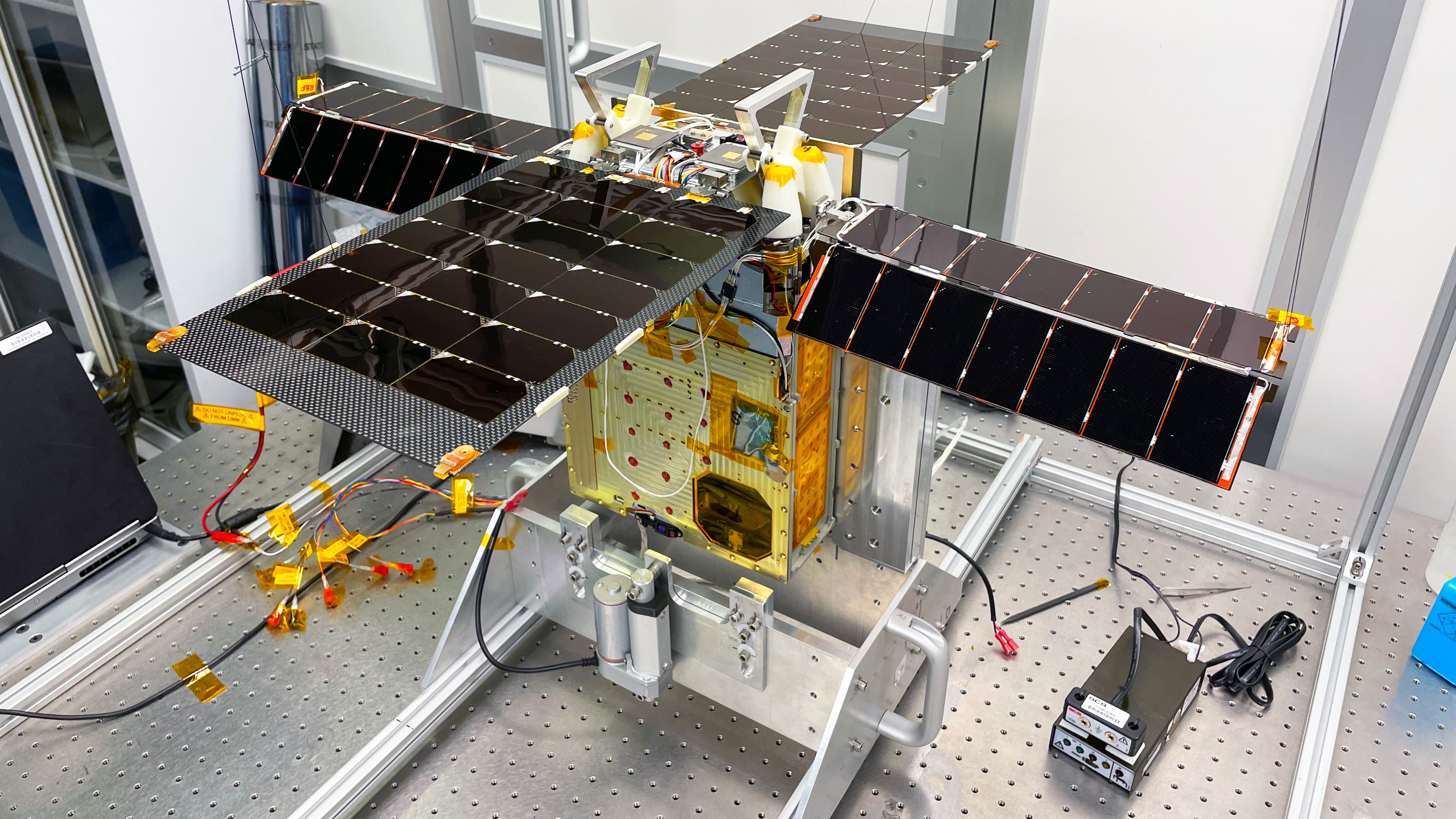NASA's tiny Lunar Flashlight moon probe may be in trouble in deep space
Three of the moon probe's four thrusters are "underperforming," NASA says.

NASA's newest tiny lunar probe is battling a thruster glitch on its way to the moon.
The spacecraft, called Lunar Flashlight, launched last month on a mission to seek out water ice on the moon. The probe was also expected to test a new "green" propellant during its four-month voyage to the moon, but its thrusters have a problem, NASA said on Thursday (Jan. 12).
"While the smallsat is largely healthy and communicating with NASA's Deep Space Network, the mission operations team has discovered that three of its four thrusters are underperforming," NASA wrote in an update. "Based on ground testing, the team thinks that the underperformance might be caused by obstructions in the fuel lines that may be limiting the propellant flow to the thrusters."
Related: NASA water-hunting Lunar Flashlight moon cubesat explained
A SpaceX Falcon 9 rocket launched the Lunar Flashlight probe to the moon on Dec. 11 alongside a Japanese moon lander carrying a lunar rover built by the United Arab Emirates. The NASA smallsat is designed to search for water ice at the moon's south pole, where NASA hopes to land astronauts just a few years from now.
Lunar Flashlight flight controllers noticed the probe's propulsion system problems about three days after launch, when it became clear it was moving under reduced thrust, NASA officials said. Now, mission engineers are drawing up new plans to fire the thrusters longer to complete Lunar Flashlight's voyage to the moon.
"The team plans to soon operate the thrusters for much longer durations, hoping to clear out any potential thruster fuel line obstructions while carrying out trajectory correction maneuvers that will keep the smallsat on course to reach its planned orbit around the moon," NASA wrote in Thursday's update. "In case the propulsion system can't be restored to full performance, the mission team is drawing up alternative plans to accomplish those maneuvers using the propulsion system with its current reduced-thrust capability."
Get the Space.com Newsletter
Breaking space news, the latest updates on rocket launches, skywatching events and more!

It's going to be a challenging recovery for Lunar Flashlight, which is about the size of a briefcase. The spacecraft "will need to perform daily trajectory correction maneuvers starting in early February to reach lunar orbit about four months from now," NASA wrote. The spacecraft fires its thrusters in short pulses, each lasting a few seconds. It uses a pink fuel known as Advanced Spacecraft Energetic Non-Toxic, which is designed to be less toxic than the hydrazine propellant on most spacecraft.
Lunar Flashlight's mission calls for the probe to enter a wide, looping orbit around the moon that will bring it within 9 miles (15 kilometers) of the surface at its closest point and send it out as far as 43,000 miles (70,000 km) from the moon at its farthest point. (The orbit is similar to one currently being tested by NASA's CAPSTONE probe and will be used by the agency's Gateway station for astronauts in the future.)
From its orbit, Lunar Flashlight will use four infrared lasers and a new type of laser reflectometer to search for surface ice in permanently shadowed craters of the moon's south pole. The spacecraft is also testing a new low-power flight computer called Sphinx that's specially designed to be radiation-tolerant in the harsh environment of space. Its new Iris radio is also expected to test ultra-precise navigation systems for future small probes headed to other destinations in our solar system, NASA has said.
Lunar Flashlight is not the only NASA moon probe to have trouble just after launch.
The CAPSTONE cubesat suffered its own woes, losing contact with Earth shortly after separating from its Rocket Lab Electron booster in July. The probe also began tumbling through space after an engine burn in September. The mission operations team, led by the Colorado-based company Advanced Space, was able to solve both glitches, allowing CAPSTONE to reach its final orbit in November.
Email Tariq Malik at tmalik@space.com or follow him @tariqjmalik. Follow us @Spacedotcom, Facebook and Instagram.
Join our Space Forums to keep talking space on the latest missions, night sky and more! And if you have a news tip, correction or comment, let us know at: community@space.com.

Tariq is the Editor-in-Chief of Space.com and joined the team in 2001, first as an intern and staff writer, and later as an editor. He covers human spaceflight, exploration and space science, as well as skywatching and entertainment. He became Space.com's Managing Editor in 2009 and Editor-in-Chief in 2019. Before joining Space.com, Tariq was a staff reporter for The Los Angeles Times covering education and city beats in La Habra, Fullerton and Huntington Beach. In October 2022, Tariq received the Harry Kolcum Award for excellence in space reporting from the National Space Club Florida Committee. He is also an Eagle Scout (yes, he has the Space Exploration merit badge) and went to Space Camp four times as a kid and a fifth time as an adult. He has journalism degrees from the University of Southern California and New York University. You can find Tariq at Space.com and as the co-host to the This Week In Space podcast with space historian Rod Pyle on the TWiT network. To see his latest project, you can follow Tariq on Twitter @tariqjmalik.









